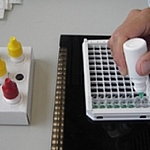Research by the NRL for Escherichia coli

Bacteria belonging to the Escherichia coli (E. coli) species are found in the natural intestinal flora of human beings and warm-blooded animals. Some representatives of these bacteria may, however, play a role as pathogens. The range of illnesses caused by E. coli is diverse and encompasses disorders like infections of the bladder and kidneys, septicaemia and meningitis as well as disorders of the gastrointestinal tract (enteritis, diarrhoea, dysentery and haemorrhagic colitis).
Bloody diarrhoea may be caused by human infections with enterohaemorrhagic E. coli (EHEC). Particularly severe cases (5-10% of the patients) may present with kidney damage and renal failure, what is known as haemolytic-uraemic syndrome (HUS). Infants, small children, older people and immunocompromised individuals are particularly at risk. In Germany about 200 cases of HUS are reported every year.
Research areas
The focus of the research activities of the BfR "National Reference Laboratory for Escherichia coli" is on the detection of the virulence properties of EHEC and other intestinal pathogenic E. coli groups as well as the characterisation of pathogenic E. coli from foods, environmental samples and clinical specimens.
Microbiological diagnosis
The goal of microbiological diagnostics is to examine the various properties of the isolated E. coli germs and to detect the formation and impact of toxins (enterotoxins, cytolysins and cytotoxins) in cell cultures.Immunological and molecular biological diagnosis
Research serves the purpose of- detecting bacterial toxins like shiga toxins in the case of EHEC and their characterisation (ELISA, Immunoblot method).
- fine typing of surface antigens (colonisation factors, flagella and fimbrias) for pathogenic E. coli (Western blot method).
- detecting the virulence genes of pathogenic E. coli. The methods used here are polymerase chain reaction (PCR), DNA hybridisation and DNA sequencing. These methods are also used to determine the clone-specific traits (analysis of constant characteristics like the house-keeping gene, flagellin gene) of the bacteria in order to examine their affiliation to known and new pathogenic clone types (genetically similar representatives).
- examining the epidemiological relationship of E. coli isolates in infections where bacteriaa are transmitted between animals and humans and the contamination of foods with pathogenic E. coli (pulse field gel electrophoresis (PFGE).
- detecting transferable DNA elements (plasmids, bacteriophages) as carriers of the virulence genes responsible for the pathogenic characteristics of bacteria and their possible transmission through horizontal gene transfer.
